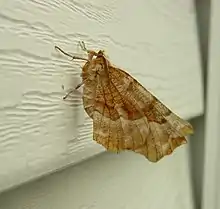Ennominae
Ennominae is the largest subfamily of the geometer moth family (Geometridae) with some 9,700 described species in 1,100 genera. They are usually a fairly small moths, though some (such as the peppered moth) grow to be considerably large. This subfamily has a global distribution. It includes some species that are notorious defoliating pests. The subfamily was first described by Philogène Auguste Joseph Duponchel in 1845.
| Ennominae | |
|---|---|
 | |
| Ourapteryx species | |
| Scientific classification | |
| Kingdom: | Animalia |
| Phylum: | Arthropoda |
| Class: | Insecta |
| Order: | Lepidoptera |
| Family: | Geometridae |
| Subfamily: | Ennominae (Duponchel, 1845) |
| Tribes | |
| |
The status of several tribes is debated. For example, the Boarmiini are sometimes massively expanded to include the Bistonini, Bupalini, Erannini, Gnophini, Melanolophini, Phaseliini and Theriini. The Nacophorini and perhaps the Campaeini might need to be merged with the Lithinini, and all three might warrant merging into the Ennomini. The group sometimes separated as Cassymini is tentatively included in the Abraxini here. The Alsophilinae, usually treated as a small subfamily in their own right, might simply be a specialized lineage of Boarmiini. [2]
Selected genera


Tribe Baptini
Tribe Boarmiini
- †Eogeometer (Fischer, Michalski & Hausmann, 2019)[1]
Tribe Bupalini
Tribe Caberini
Tribe Campaeini
Tribe Colotoini
Tribe Erannini
Tribe Gnophini
Tribe Gonodontini
- Aethiopodes (sometimes in Odontopera)
- Odontopera
Genera incertae sedis
Numerous genera have hitherto not been definitely assigned to a tribe.[3] These include:
- Adalbertia
- Anavitrinelia
- Bichroma
- Chelotephrina
- Chemerina
- Chesiadodes
- Ciropteryx
- Compsoptera
- Cyclomia
- Declana - Nacophorini?
- Enconista
- Entomopteryx
- Eubarnesia
- Geolyces
- Guara
- Hispophora
- Hoplosauris - Ennomini?
- Hulstina
- Hyalinetta
- Hyalostenele
- Hylemeridia
- Hypochrosis
- Leptepistomion
- Lhommeia
- Liodesina
- Lobocraspeda
- Melanochroia
- Mericisca
- Metanema
- Metarranthis
- Miantochora
- Nepterotaea
- Neritodes - Macariini?
- Onychora
- Ortaliella
- Orthocabera - Abraxini (Cassymini if distinct)?
- Orthofidonia - Boarmiini?
- Paraglaucina
- Parapheromia
- Prionomelia
- Probole
- Pseudocoremia - Boarmiini?
- Pterotaea
- Pyrinia
- Rhoptria
- Slossonia
- Sperrya
- Syncirsodes
- Synglochis
- Toulgoetia
- Tracheops
- Tritocleis (extinct)
- Xenoecista
- Xylopteryx
- Zamarada - Abraxini (Cassymini if distinct)?
Fossil
In 2019, the first geometrid caterpillar in Baltic amber was discovered by German scientists. Described under Eogeometer vadens, it measured about 5 mm (0.20 in), and was estimated to be 44 million years old, dating back to Eocene epoch. It was described as the earliest evidence for the subfamily of Ennominae, particularly the tribe of Boarmiini.[1]
References
- Fischer, Thilo C.; Michalski, Artur; Hausmann, Axel (2019). "Geometrid caterpillar in Eocene Baltic amber (Lepidoptera, Geometridae)". Scientific Reports. 9 (1): Article number 17201. doi:10.1038/s41598-019-53734-w. PMC 6868187. PMID 31748672.
- Holloway (1994), Young (2008)
- See references in Savela (2008)
- Holloway, J. D. (1994), The Moths of Borneo: Family Geometridae, Subfamily Ennominae, London
- Savela, Markku. "Ennominae". Lepidoptera and Some Other Life Forms. Retrieved July 1, 2019.
- Young, Catherine J. (2008), Characterisation of the Australian Nacophorini using adult morphology, and phylogeny of the Geometridae based on morphological characters (PDF), Zootaxa, pp. 1–141